Analyzing Employee Relations and Stakeholder Influence at Sainsbury's
VerifiedAdded on 2022/12/26
|10
|2584
|41
Report
AI Summary
This report analyzes employee relations within Sainsbury's, a major UK supermarket chain, exploring their value and importance in fostering a positive work environment. It delves into the fundamentals of employment law, outlining the rights, duties, and obligations of both employers and employees, while also examining mechanisms for maintaining healthy employment relationships. A key focus is on stakeholder analysis, identifying various stakeholders and assessing the impact of their engagement on building strong employee relations. The report further investigates the consequences of both positive and negative employee relations on different stakeholders, providing a comprehensive overview of the topic. The report also highlights the laws like employee rights act, 1961 and the health and safety act, 1974. It emphasizes the importance of communication, involvement in decision-making, and a well-defined organizational culture. The stakeholder analysis section details the importance of stakeholder engagement and contribution in building employment relations.
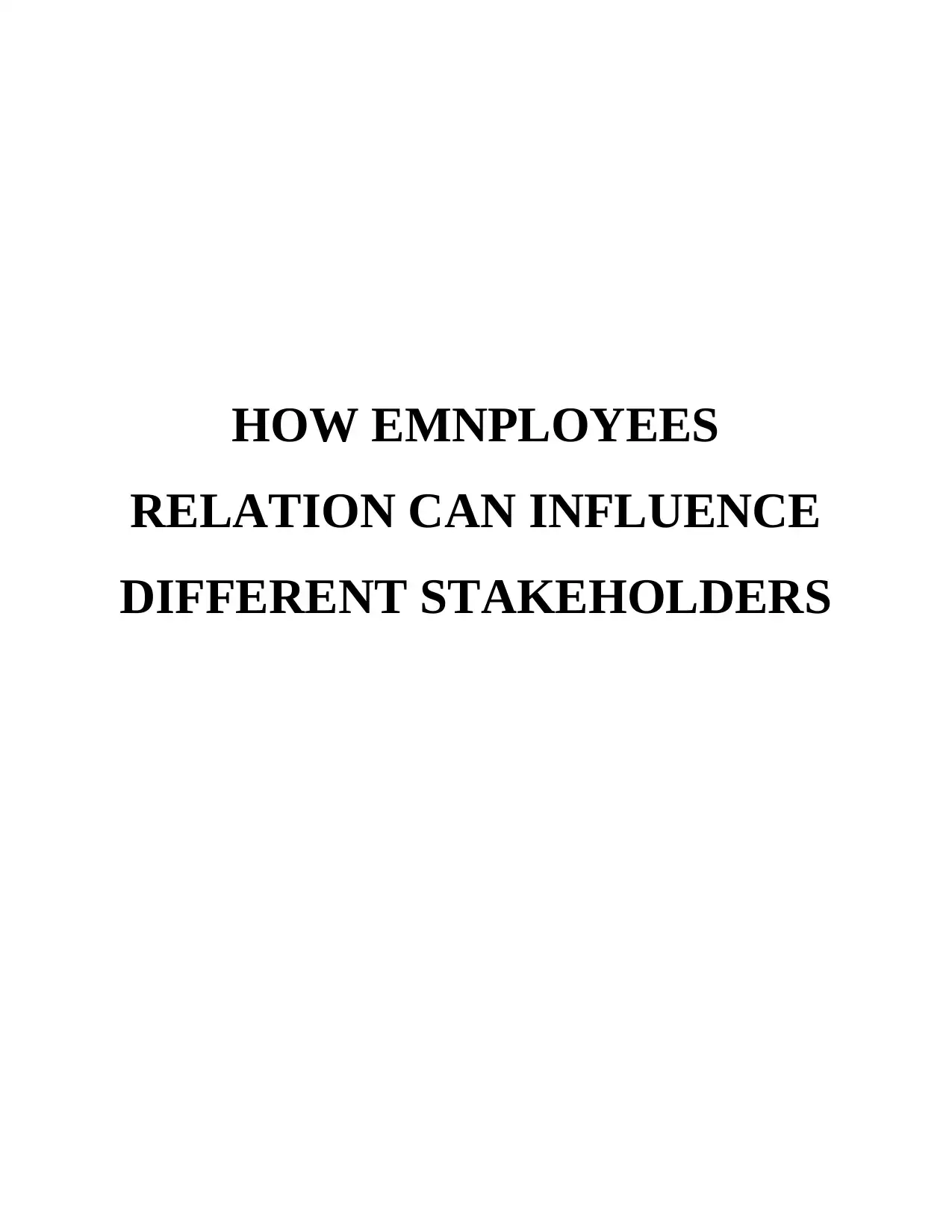
HOW EMNPLOYEES
RELATION CAN INFLUENCE
DIFFERENT STAKEHOLDERS
RELATION CAN INFLUENCE
DIFFERENT STAKEHOLDERS
Paraphrase This Document
Need a fresh take? Get an instant paraphrase of this document with our AI Paraphraser
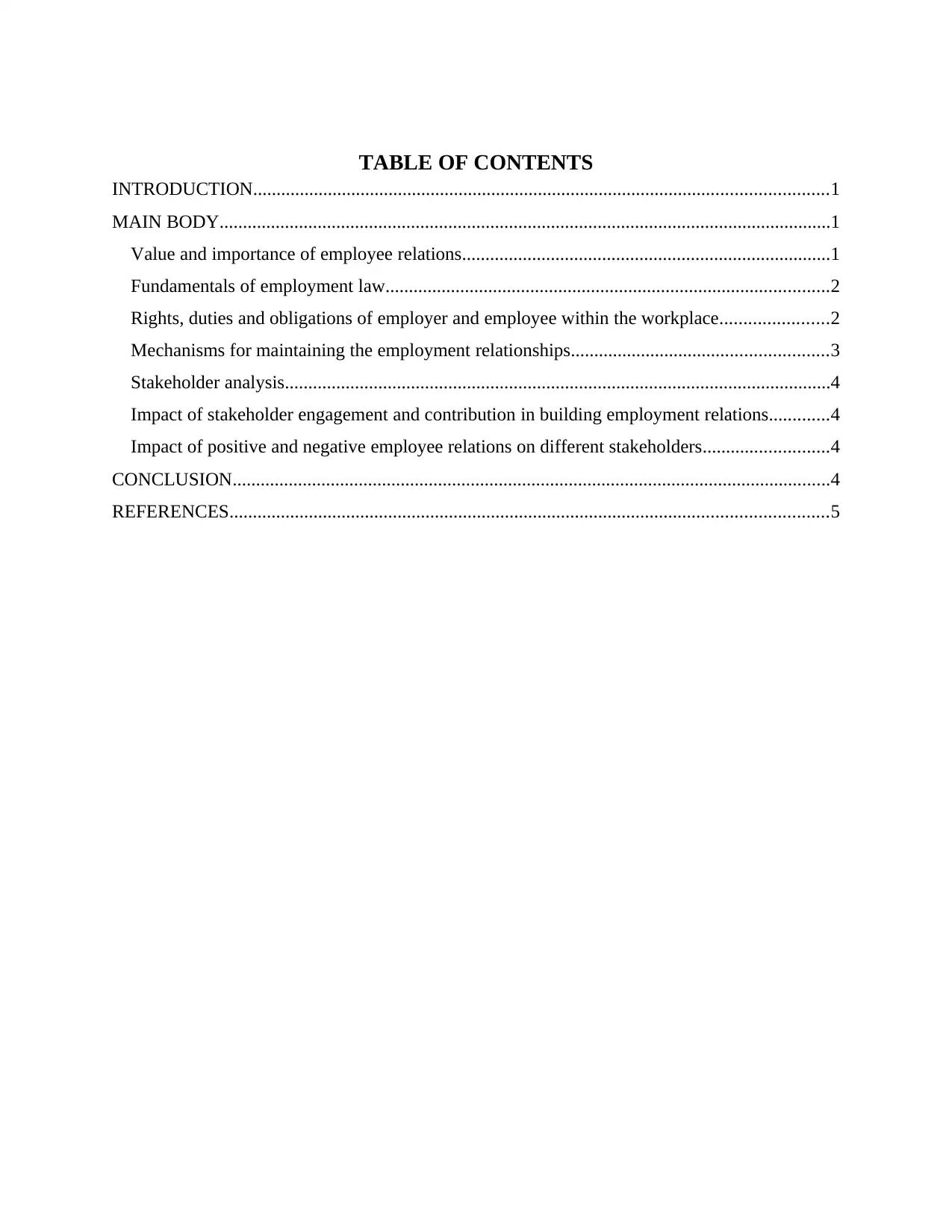
TABLE OF CONTENTS
INTRODUCTION...........................................................................................................................1
MAIN BODY...................................................................................................................................1
Value and importance of employee relations...............................................................................1
Fundamentals of employment law...............................................................................................2
Rights, duties and obligations of employer and employee within the workplace.......................2
Mechanisms for maintaining the employment relationships.......................................................3
Stakeholder analysis.....................................................................................................................4
Impact of stakeholder engagement and contribution in building employment relations.............4
Impact of positive and negative employee relations on different stakeholders...........................4
CONCLUSION................................................................................................................................4
REFERENCES................................................................................................................................5
INTRODUCTION...........................................................................................................................1
MAIN BODY...................................................................................................................................1
Value and importance of employee relations...............................................................................1
Fundamentals of employment law...............................................................................................2
Rights, duties and obligations of employer and employee within the workplace.......................2
Mechanisms for maintaining the employment relationships.......................................................3
Stakeholder analysis.....................................................................................................................4
Impact of stakeholder engagement and contribution in building employment relations.............4
Impact of positive and negative employee relations on different stakeholders...........................4
CONCLUSION................................................................................................................................4
REFERENCES................................................................................................................................5
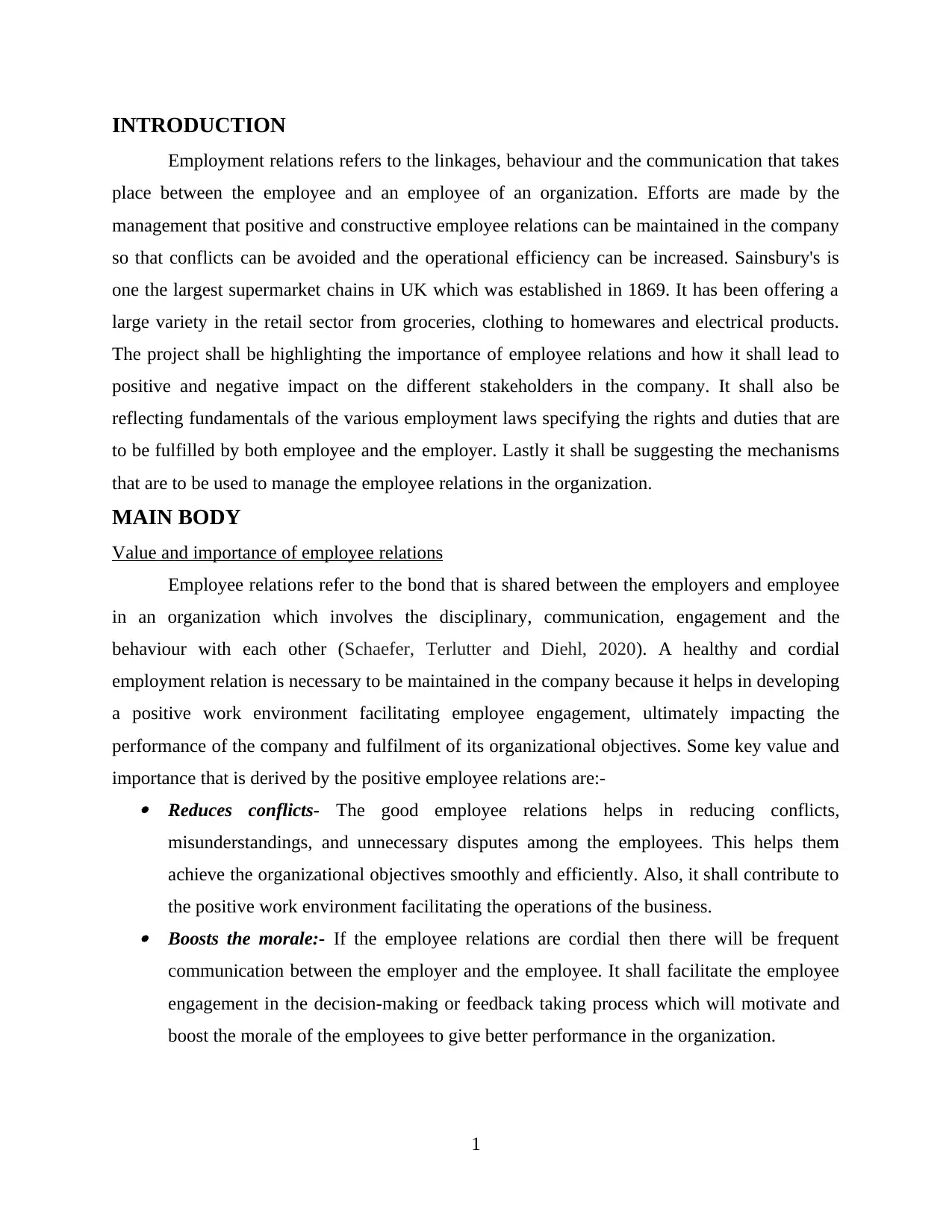
INTRODUCTION
Employment relations refers to the linkages, behaviour and the communication that takes
place between the employee and an employee of an organization. Efforts are made by the
management that positive and constructive employee relations can be maintained in the company
so that conflicts can be avoided and the operational efficiency can be increased. Sainsbury's is
one the largest supermarket chains in UK which was established in 1869. It has been offering a
large variety in the retail sector from groceries, clothing to homewares and electrical products.
The project shall be highlighting the importance of employee relations and how it shall lead to
positive and negative impact on the different stakeholders in the company. It shall also be
reflecting fundamentals of the various employment laws specifying the rights and duties that are
to be fulfilled by both employee and the employer. Lastly it shall be suggesting the mechanisms
that are to be used to manage the employee relations in the organization.
MAIN BODY
Value and importance of employee relations
Employee relations refer to the bond that is shared between the employers and employee
in an organization which involves the disciplinary, communication, engagement and the
behaviour with each other (Schaefer, Terlutter and Diehl, 2020). A healthy and cordial
employment relation is necessary to be maintained in the company because it helps in developing
a positive work environment facilitating employee engagement, ultimately impacting the
performance of the company and fulfilment of its organizational objectives. Some key value and
importance that is derived by the positive employee relations are:- Reduces conflicts- The good employee relations helps in reducing conflicts,
misunderstandings, and unnecessary disputes among the employees. This helps them
achieve the organizational objectives smoothly and efficiently. Also, it shall contribute to
the positive work environment facilitating the operations of the business. Boosts the morale:- If the employee relations are cordial then there will be frequent
communication between the employer and the employee. It shall facilitate the employee
engagement in the decision-making or feedback taking process which will motivate and
boost the morale of the employees to give better performance in the organization.
1
Employment relations refers to the linkages, behaviour and the communication that takes
place between the employee and an employee of an organization. Efforts are made by the
management that positive and constructive employee relations can be maintained in the company
so that conflicts can be avoided and the operational efficiency can be increased. Sainsbury's is
one the largest supermarket chains in UK which was established in 1869. It has been offering a
large variety in the retail sector from groceries, clothing to homewares and electrical products.
The project shall be highlighting the importance of employee relations and how it shall lead to
positive and negative impact on the different stakeholders in the company. It shall also be
reflecting fundamentals of the various employment laws specifying the rights and duties that are
to be fulfilled by both employee and the employer. Lastly it shall be suggesting the mechanisms
that are to be used to manage the employee relations in the organization.
MAIN BODY
Value and importance of employee relations
Employee relations refer to the bond that is shared between the employers and employee
in an organization which involves the disciplinary, communication, engagement and the
behaviour with each other (Schaefer, Terlutter and Diehl, 2020). A healthy and cordial
employment relation is necessary to be maintained in the company because it helps in developing
a positive work environment facilitating employee engagement, ultimately impacting the
performance of the company and fulfilment of its organizational objectives. Some key value and
importance that is derived by the positive employee relations are:- Reduces conflicts- The good employee relations helps in reducing conflicts,
misunderstandings, and unnecessary disputes among the employees. This helps them
achieve the organizational objectives smoothly and efficiently. Also, it shall contribute to
the positive work environment facilitating the operations of the business. Boosts the morale:- If the employee relations are cordial then there will be frequent
communication between the employer and the employee. It shall facilitate the employee
engagement in the decision-making or feedback taking process which will motivate and
boost the morale of the employees to give better performance in the organization.
1
⊘ This is a preview!⊘
Do you want full access?
Subscribe today to unlock all pages.

Trusted by 1+ million students worldwide
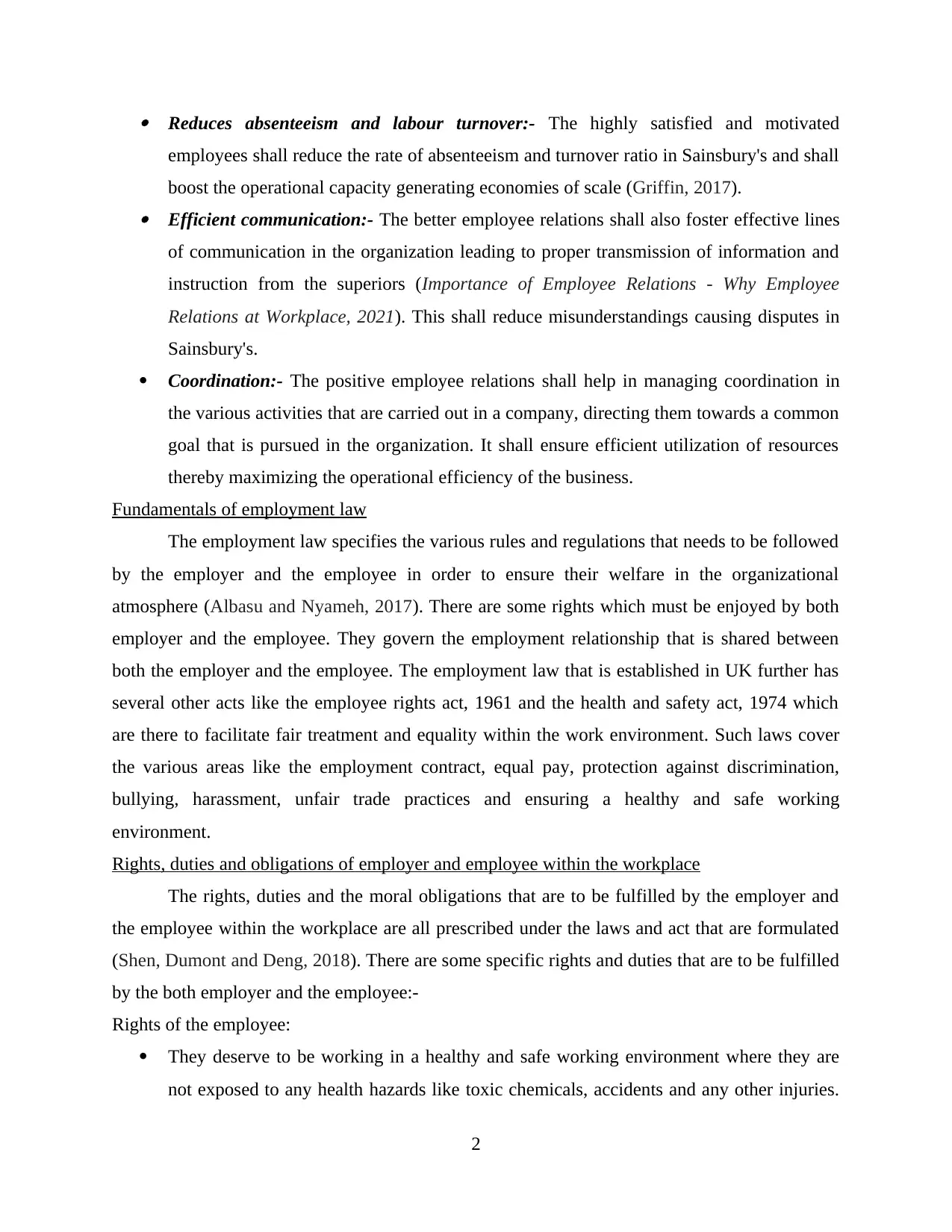
Reduces absenteeism and labour turnover:- The highly satisfied and motivated
employees shall reduce the rate of absenteeism and turnover ratio in Sainsbury's and shall
boost the operational capacity generating economies of scale (Griffin, 2017). Efficient communication:- The better employee relations shall also foster effective lines
of communication in the organization leading to proper transmission of information and
instruction from the superiors (Importance of Employee Relations - Why Employee
Relations at Workplace, 2021). This shall reduce misunderstandings causing disputes in
Sainsbury's.
Coordination:- The positive employee relations shall help in managing coordination in
the various activities that are carried out in a company, directing them towards a common
goal that is pursued in the organization. It shall ensure efficient utilization of resources
thereby maximizing the operational efficiency of the business.
Fundamentals of employment law
The employment law specifies the various rules and regulations that needs to be followed
by the employer and the employee in order to ensure their welfare in the organizational
atmosphere (Albasu and Nyameh, 2017). There are some rights which must be enjoyed by both
employer and the employee. They govern the employment relationship that is shared between
both the employer and the employee. The employment law that is established in UK further has
several other acts like the employee rights act, 1961 and the health and safety act, 1974 which
are there to facilitate fair treatment and equality within the work environment. Such laws cover
the various areas like the employment contract, equal pay, protection against discrimination,
bullying, harassment, unfair trade practices and ensuring a healthy and safe working
environment.
Rights, duties and obligations of employer and employee within the workplace
The rights, duties and the moral obligations that are to be fulfilled by the employer and
the employee within the workplace are all prescribed under the laws and act that are formulated
(Shen, Dumont and Deng, 2018). There are some specific rights and duties that are to be fulfilled
by the both employer and the employee:-
Rights of the employee:
They deserve to be working in a healthy and safe working environment where they are
not exposed to any health hazards like toxic chemicals, accidents and any other injuries.
2
employees shall reduce the rate of absenteeism and turnover ratio in Sainsbury's and shall
boost the operational capacity generating economies of scale (Griffin, 2017). Efficient communication:- The better employee relations shall also foster effective lines
of communication in the organization leading to proper transmission of information and
instruction from the superiors (Importance of Employee Relations - Why Employee
Relations at Workplace, 2021). This shall reduce misunderstandings causing disputes in
Sainsbury's.
Coordination:- The positive employee relations shall help in managing coordination in
the various activities that are carried out in a company, directing them towards a common
goal that is pursued in the organization. It shall ensure efficient utilization of resources
thereby maximizing the operational efficiency of the business.
Fundamentals of employment law
The employment law specifies the various rules and regulations that needs to be followed
by the employer and the employee in order to ensure their welfare in the organizational
atmosphere (Albasu and Nyameh, 2017). There are some rights which must be enjoyed by both
employer and the employee. They govern the employment relationship that is shared between
both the employer and the employee. The employment law that is established in UK further has
several other acts like the employee rights act, 1961 and the health and safety act, 1974 which
are there to facilitate fair treatment and equality within the work environment. Such laws cover
the various areas like the employment contract, equal pay, protection against discrimination,
bullying, harassment, unfair trade practices and ensuring a healthy and safe working
environment.
Rights, duties and obligations of employer and employee within the workplace
The rights, duties and the moral obligations that are to be fulfilled by the employer and
the employee within the workplace are all prescribed under the laws and act that are formulated
(Shen, Dumont and Deng, 2018). There are some specific rights and duties that are to be fulfilled
by the both employer and the employee:-
Rights of the employee:
They deserve to be working in a healthy and safe working environment where they are
not exposed to any health hazards like toxic chemicals, accidents and any other injuries.
2
Paraphrase This Document
Need a fresh take? Get an instant paraphrase of this document with our AI Paraphraser
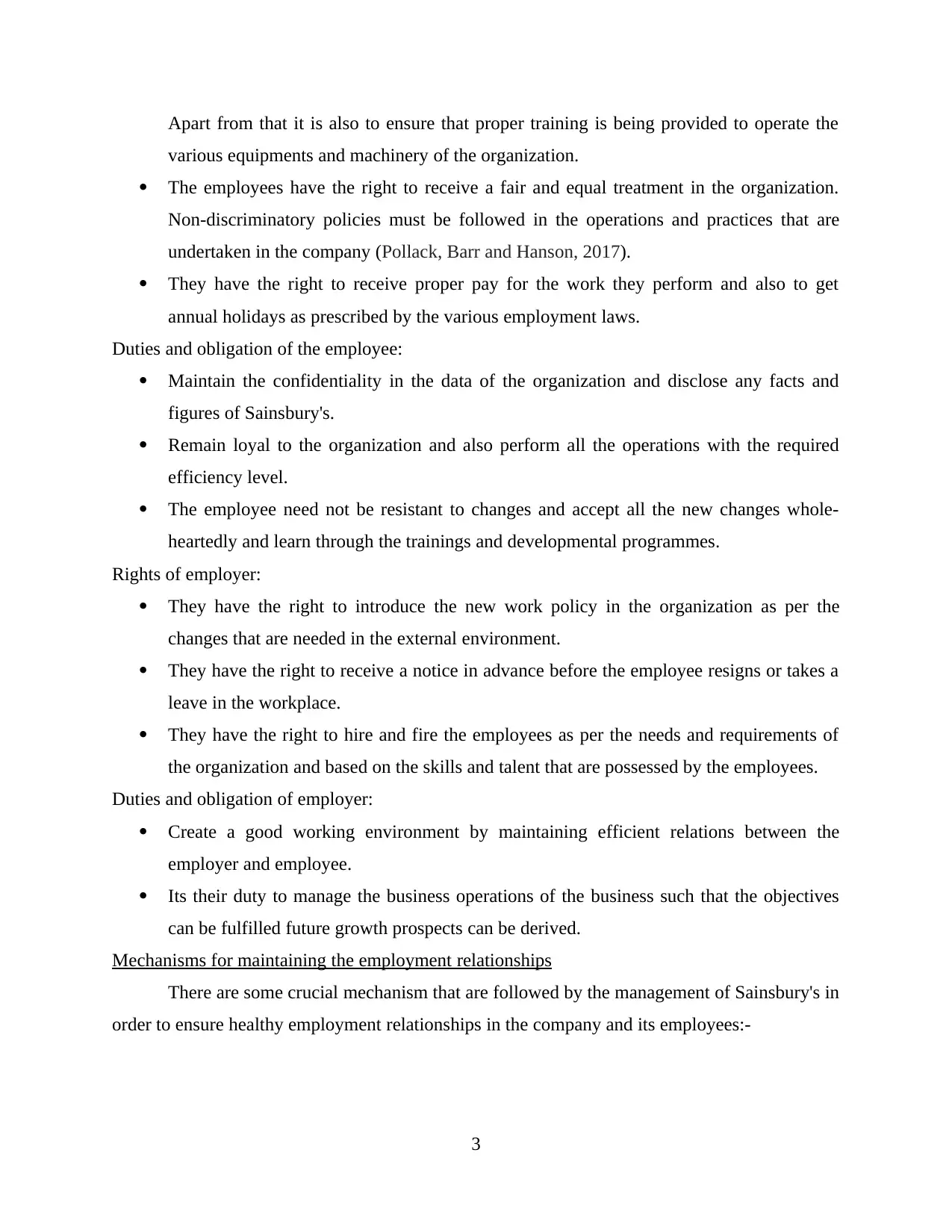
Apart from that it is also to ensure that proper training is being provided to operate the
various equipments and machinery of the organization.
The employees have the right to receive a fair and equal treatment in the organization.
Non-discriminatory policies must be followed in the operations and practices that are
undertaken in the company (Pollack, Barr and Hanson, 2017).
They have the right to receive proper pay for the work they perform and also to get
annual holidays as prescribed by the various employment laws.
Duties and obligation of the employee:
Maintain the confidentiality in the data of the organization and disclose any facts and
figures of Sainsbury's.
Remain loyal to the organization and also perform all the operations with the required
efficiency level.
The employee need not be resistant to changes and accept all the new changes whole-
heartedly and learn through the trainings and developmental programmes.
Rights of employer:
They have the right to introduce the new work policy in the organization as per the
changes that are needed in the external environment.
They have the right to receive a notice in advance before the employee resigns or takes a
leave in the workplace.
They have the right to hire and fire the employees as per the needs and requirements of
the organization and based on the skills and talent that are possessed by the employees.
Duties and obligation of employer:
Create a good working environment by maintaining efficient relations between the
employer and employee.
Its their duty to manage the business operations of the business such that the objectives
can be fulfilled future growth prospects can be derived.
Mechanisms for maintaining the employment relationships
There are some crucial mechanism that are followed by the management of Sainsbury's in
order to ensure healthy employment relationships in the company and its employees:-
3
various equipments and machinery of the organization.
The employees have the right to receive a fair and equal treatment in the organization.
Non-discriminatory policies must be followed in the operations and practices that are
undertaken in the company (Pollack, Barr and Hanson, 2017).
They have the right to receive proper pay for the work they perform and also to get
annual holidays as prescribed by the various employment laws.
Duties and obligation of the employee:
Maintain the confidentiality in the data of the organization and disclose any facts and
figures of Sainsbury's.
Remain loyal to the organization and also perform all the operations with the required
efficiency level.
The employee need not be resistant to changes and accept all the new changes whole-
heartedly and learn through the trainings and developmental programmes.
Rights of employer:
They have the right to introduce the new work policy in the organization as per the
changes that are needed in the external environment.
They have the right to receive a notice in advance before the employee resigns or takes a
leave in the workplace.
They have the right to hire and fire the employees as per the needs and requirements of
the organization and based on the skills and talent that are possessed by the employees.
Duties and obligation of employer:
Create a good working environment by maintaining efficient relations between the
employer and employee.
Its their duty to manage the business operations of the business such that the objectives
can be fulfilled future growth prospects can be derived.
Mechanisms for maintaining the employment relationships
There are some crucial mechanism that are followed by the management of Sainsbury's in
order to ensure healthy employment relationships in the company and its employees:-
3
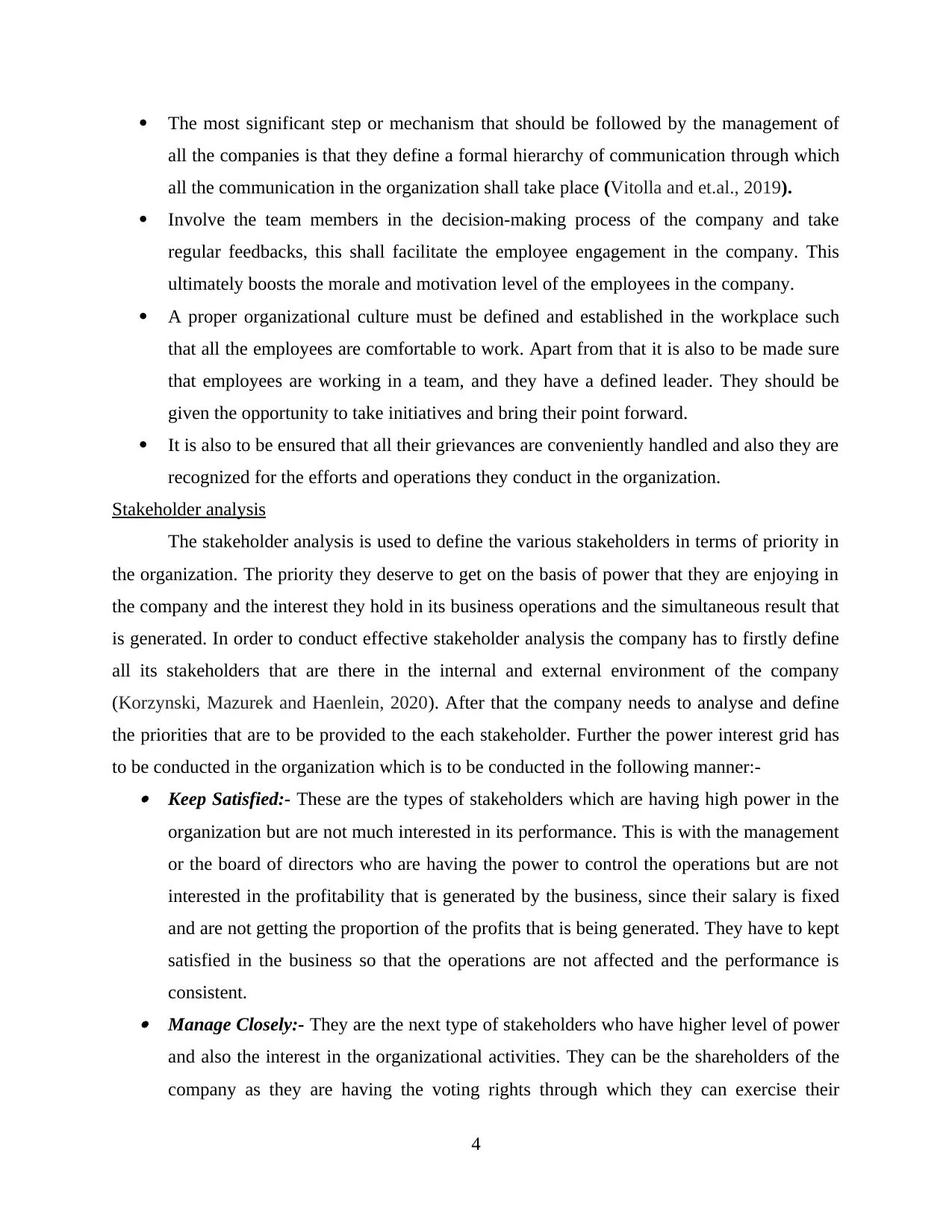
The most significant step or mechanism that should be followed by the management of
all the companies is that they define a formal hierarchy of communication through which
all the communication in the organization shall take place (Vitolla and et.al., 2019).
Involve the team members in the decision-making process of the company and take
regular feedbacks, this shall facilitate the employee engagement in the company. This
ultimately boosts the morale and motivation level of the employees in the company.
A proper organizational culture must be defined and established in the workplace such
that all the employees are comfortable to work. Apart from that it is also to be made sure
that employees are working in a team, and they have a defined leader. They should be
given the opportunity to take initiatives and bring their point forward.
It is also to be ensured that all their grievances are conveniently handled and also they are
recognized for the efforts and operations they conduct in the organization.
Stakeholder analysis
The stakeholder analysis is used to define the various stakeholders in terms of priority in
the organization. The priority they deserve to get on the basis of power that they are enjoying in
the company and the interest they hold in its business operations and the simultaneous result that
is generated. In order to conduct effective stakeholder analysis the company has to firstly define
all its stakeholders that are there in the internal and external environment of the company
(Korzynski, Mazurek and Haenlein, 2020). After that the company needs to analyse and define
the priorities that are to be provided to the each stakeholder. Further the power interest grid has
to be conducted in the organization which is to be conducted in the following manner:- Keep Satisfied:- These are the types of stakeholders which are having high power in the
organization but are not much interested in its performance. This is with the management
or the board of directors who are having the power to control the operations but are not
interested in the profitability that is generated by the business, since their salary is fixed
and are not getting the proportion of the profits that is being generated. They have to kept
satisfied in the business so that the operations are not affected and the performance is
consistent. Manage Closely:- They are the next type of stakeholders who have higher level of power
and also the interest in the organizational activities. They can be the shareholders of the
company as they are having the voting rights through which they can exercise their
4
all the companies is that they define a formal hierarchy of communication through which
all the communication in the organization shall take place (Vitolla and et.al., 2019).
Involve the team members in the decision-making process of the company and take
regular feedbacks, this shall facilitate the employee engagement in the company. This
ultimately boosts the morale and motivation level of the employees in the company.
A proper organizational culture must be defined and established in the workplace such
that all the employees are comfortable to work. Apart from that it is also to be made sure
that employees are working in a team, and they have a defined leader. They should be
given the opportunity to take initiatives and bring their point forward.
It is also to be ensured that all their grievances are conveniently handled and also they are
recognized for the efforts and operations they conduct in the organization.
Stakeholder analysis
The stakeholder analysis is used to define the various stakeholders in terms of priority in
the organization. The priority they deserve to get on the basis of power that they are enjoying in
the company and the interest they hold in its business operations and the simultaneous result that
is generated. In order to conduct effective stakeholder analysis the company has to firstly define
all its stakeholders that are there in the internal and external environment of the company
(Korzynski, Mazurek and Haenlein, 2020). After that the company needs to analyse and define
the priorities that are to be provided to the each stakeholder. Further the power interest grid has
to be conducted in the organization which is to be conducted in the following manner:- Keep Satisfied:- These are the types of stakeholders which are having high power in the
organization but are not much interested in its performance. This is with the management
or the board of directors who are having the power to control the operations but are not
interested in the profitability that is generated by the business, since their salary is fixed
and are not getting the proportion of the profits that is being generated. They have to kept
satisfied in the business so that the operations are not affected and the performance is
consistent. Manage Closely:- They are the next type of stakeholders who have higher level of power
and also the interest in the organizational activities. They can be the shareholders of the
company as they are having the voting rights through which they can exercise their
4
⊘ This is a preview!⊘
Do you want full access?
Subscribe today to unlock all pages.

Trusted by 1+ million students worldwide
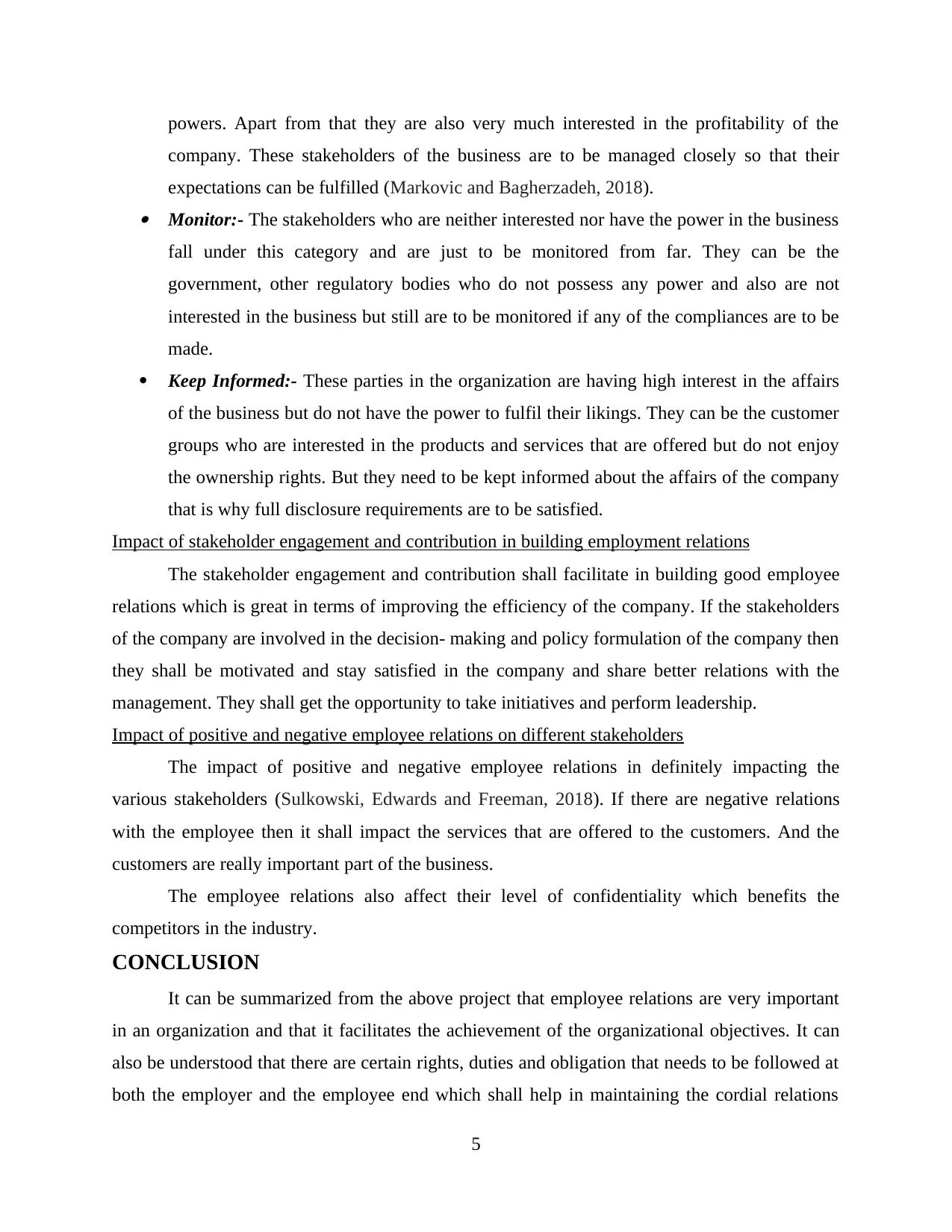
powers. Apart from that they are also very much interested in the profitability of the
company. These stakeholders of the business are to be managed closely so that their
expectations can be fulfilled (Markovic and Bagherzadeh, 2018). Monitor:- The stakeholders who are neither interested nor have the power in the business
fall under this category and are just to be monitored from far. They can be the
government, other regulatory bodies who do not possess any power and also are not
interested in the business but still are to be monitored if any of the compliances are to be
made.
Keep Informed:- These parties in the organization are having high interest in the affairs
of the business but do not have the power to fulfil their likings. They can be the customer
groups who are interested in the products and services that are offered but do not enjoy
the ownership rights. But they need to be kept informed about the affairs of the company
that is why full disclosure requirements are to be satisfied.
Impact of stakeholder engagement and contribution in building employment relations
The stakeholder engagement and contribution shall facilitate in building good employee
relations which is great in terms of improving the efficiency of the company. If the stakeholders
of the company are involved in the decision- making and policy formulation of the company then
they shall be motivated and stay satisfied in the company and share better relations with the
management. They shall get the opportunity to take initiatives and perform leadership.
Impact of positive and negative employee relations on different stakeholders
The impact of positive and negative employee relations in definitely impacting the
various stakeholders (Sulkowski, Edwards and Freeman, 2018). If there are negative relations
with the employee then it shall impact the services that are offered to the customers. And the
customers are really important part of the business.
The employee relations also affect their level of confidentiality which benefits the
competitors in the industry.
CONCLUSION
It can be summarized from the above project that employee relations are very important
in an organization and that it facilitates the achievement of the organizational objectives. It can
also be understood that there are certain rights, duties and obligation that needs to be followed at
both the employer and the employee end which shall help in maintaining the cordial relations
5
company. These stakeholders of the business are to be managed closely so that their
expectations can be fulfilled (Markovic and Bagherzadeh, 2018). Monitor:- The stakeholders who are neither interested nor have the power in the business
fall under this category and are just to be monitored from far. They can be the
government, other regulatory bodies who do not possess any power and also are not
interested in the business but still are to be monitored if any of the compliances are to be
made.
Keep Informed:- These parties in the organization are having high interest in the affairs
of the business but do not have the power to fulfil their likings. They can be the customer
groups who are interested in the products and services that are offered but do not enjoy
the ownership rights. But they need to be kept informed about the affairs of the company
that is why full disclosure requirements are to be satisfied.
Impact of stakeholder engagement and contribution in building employment relations
The stakeholder engagement and contribution shall facilitate in building good employee
relations which is great in terms of improving the efficiency of the company. If the stakeholders
of the company are involved in the decision- making and policy formulation of the company then
they shall be motivated and stay satisfied in the company and share better relations with the
management. They shall get the opportunity to take initiatives and perform leadership.
Impact of positive and negative employee relations on different stakeholders
The impact of positive and negative employee relations in definitely impacting the
various stakeholders (Sulkowski, Edwards and Freeman, 2018). If there are negative relations
with the employee then it shall impact the services that are offered to the customers. And the
customers are really important part of the business.
The employee relations also affect their level of confidentiality which benefits the
competitors in the industry.
CONCLUSION
It can be summarized from the above project that employee relations are very important
in an organization and that it facilitates the achievement of the organizational objectives. It can
also be understood that there are certain rights, duties and obligation that needs to be followed at
both the employer and the employee end which shall help in maintaining the cordial relations
5
Paraphrase This Document
Need a fresh take? Get an instant paraphrase of this document with our AI Paraphraser
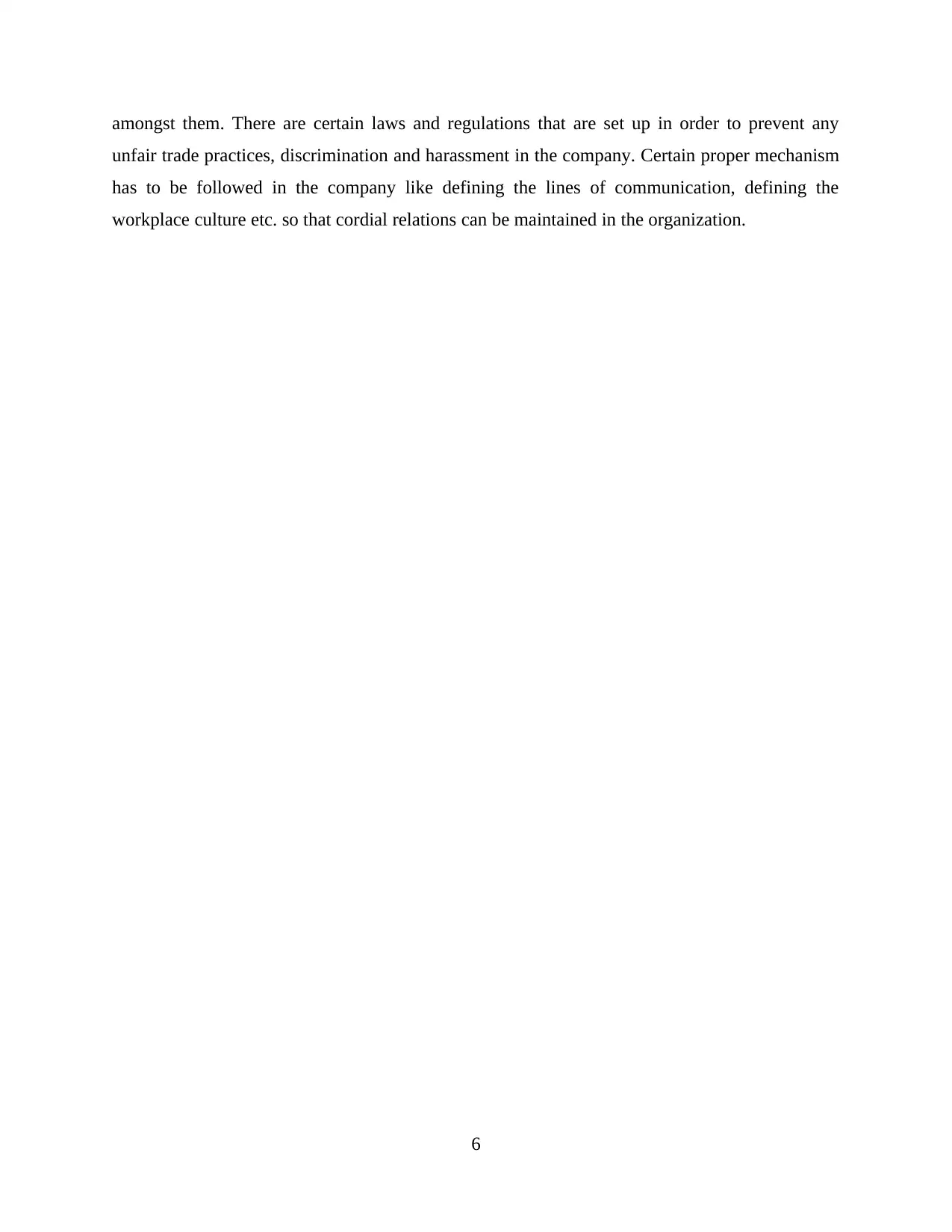
amongst them. There are certain laws and regulations that are set up in order to prevent any
unfair trade practices, discrimination and harassment in the company. Certain proper mechanism
has to be followed in the company like defining the lines of communication, defining the
workplace culture etc. so that cordial relations can be maintained in the organization.
6
unfair trade practices, discrimination and harassment in the company. Certain proper mechanism
has to be followed in the company like defining the lines of communication, defining the
workplace culture etc. so that cordial relations can be maintained in the organization.
6
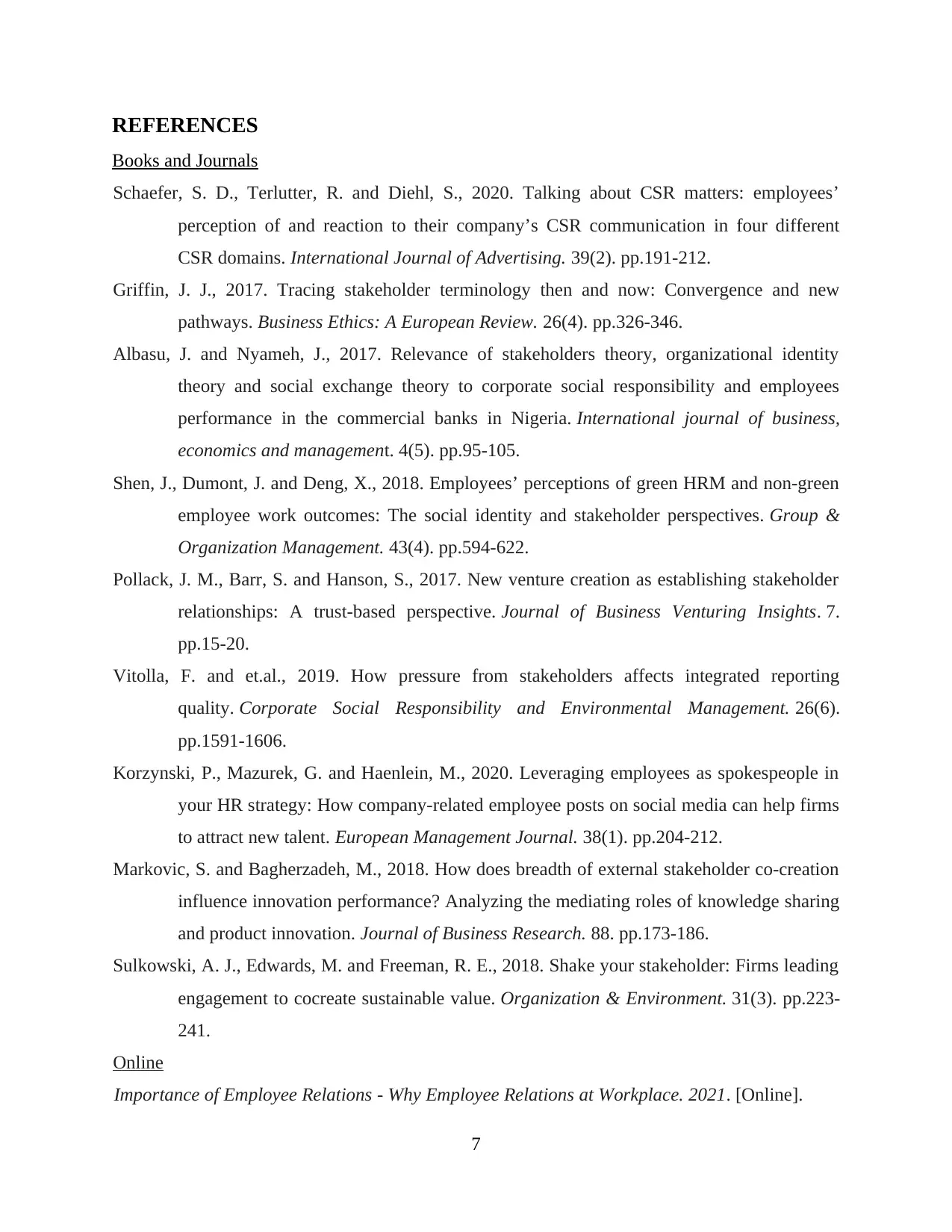
REFERENCES
Books and Journals
Schaefer, S. D., Terlutter, R. and Diehl, S., 2020. Talking about CSR matters: employees’
perception of and reaction to their company’s CSR communication in four different
CSR domains. International Journal of Advertising. 39(2). pp.191-212.
Griffin, J. J., 2017. Tracing stakeholder terminology then and now: Convergence and new
pathways. Business Ethics: A European Review. 26(4). pp.326-346.
Albasu, J. and Nyameh, J., 2017. Relevance of stakeholders theory, organizational identity
theory and social exchange theory to corporate social responsibility and employees
performance in the commercial banks in Nigeria. International journal of business,
economics and management. 4(5). pp.95-105.
Shen, J., Dumont, J. and Deng, X., 2018. Employees’ perceptions of green HRM and non-green
employee work outcomes: The social identity and stakeholder perspectives. Group &
Organization Management. 43(4). pp.594-622.
Pollack, J. M., Barr, S. and Hanson, S., 2017. New venture creation as establishing stakeholder
relationships: A trust-based perspective. Journal of Business Venturing Insights. 7.
pp.15-20.
Vitolla, F. and et.al., 2019. How pressure from stakeholders affects integrated reporting
quality. Corporate Social Responsibility and Environmental Management. 26(6).
pp.1591-1606.
Korzynski, P., Mazurek, G. and Haenlein, M., 2020. Leveraging employees as spokespeople in
your HR strategy: How company-related employee posts on social media can help firms
to attract new talent. European Management Journal. 38(1). pp.204-212.
Markovic, S. and Bagherzadeh, M., 2018. How does breadth of external stakeholder co-creation
influence innovation performance? Analyzing the mediating roles of knowledge sharing
and product innovation. Journal of Business Research. 88. pp.173-186.
Sulkowski, A. J., Edwards, M. and Freeman, R. E., 2018. Shake your stakeholder: Firms leading
engagement to cocreate sustainable value. Organization & Environment. 31(3). pp.223-
241.
Online
Importance of Employee Relations - Why Employee Relations at Workplace. 2021. [Online].
7
Books and Journals
Schaefer, S. D., Terlutter, R. and Diehl, S., 2020. Talking about CSR matters: employees’
perception of and reaction to their company’s CSR communication in four different
CSR domains. International Journal of Advertising. 39(2). pp.191-212.
Griffin, J. J., 2017. Tracing stakeholder terminology then and now: Convergence and new
pathways. Business Ethics: A European Review. 26(4). pp.326-346.
Albasu, J. and Nyameh, J., 2017. Relevance of stakeholders theory, organizational identity
theory and social exchange theory to corporate social responsibility and employees
performance in the commercial banks in Nigeria. International journal of business,
economics and management. 4(5). pp.95-105.
Shen, J., Dumont, J. and Deng, X., 2018. Employees’ perceptions of green HRM and non-green
employee work outcomes: The social identity and stakeholder perspectives. Group &
Organization Management. 43(4). pp.594-622.
Pollack, J. M., Barr, S. and Hanson, S., 2017. New venture creation as establishing stakeholder
relationships: A trust-based perspective. Journal of Business Venturing Insights. 7.
pp.15-20.
Vitolla, F. and et.al., 2019. How pressure from stakeholders affects integrated reporting
quality. Corporate Social Responsibility and Environmental Management. 26(6).
pp.1591-1606.
Korzynski, P., Mazurek, G. and Haenlein, M., 2020. Leveraging employees as spokespeople in
your HR strategy: How company-related employee posts on social media can help firms
to attract new talent. European Management Journal. 38(1). pp.204-212.
Markovic, S. and Bagherzadeh, M., 2018. How does breadth of external stakeholder co-creation
influence innovation performance? Analyzing the mediating roles of knowledge sharing
and product innovation. Journal of Business Research. 88. pp.173-186.
Sulkowski, A. J., Edwards, M. and Freeman, R. E., 2018. Shake your stakeholder: Firms leading
engagement to cocreate sustainable value. Organization & Environment. 31(3). pp.223-
241.
Online
Importance of Employee Relations - Why Employee Relations at Workplace. 2021. [Online].
7
⊘ This is a preview!⊘
Do you want full access?
Subscribe today to unlock all pages.

Trusted by 1+ million students worldwide

Available through: <https://www.managementstudyguide.com/importance-of-employee-
relations.htm>
8
relations.htm>
8
1 out of 10
Related Documents
Your All-in-One AI-Powered Toolkit for Academic Success.
+13062052269
info@desklib.com
Available 24*7 on WhatsApp / Email
![[object Object]](/_next/static/media/star-bottom.7253800d.svg)
Unlock your academic potential
Copyright © 2020–2025 A2Z Services. All Rights Reserved. Developed and managed by ZUCOL.





